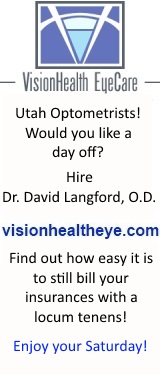 Corneal Topography for Every Exam?
Corneal Topography for Every Exam?
Until I heard a Nidek podcast, I had never even heard of someone doing a corneal topography on all complete eye exams. Dr. Marc R. Bloomenstein is of the opinion that the information gleaned from a corneal topography is essential in evaluating every patient’s glasses prescription, eye health, contact lens evaluation, and surgery evaluation.
Wow, that thought has never even occurred to me before. EVERY patient? Holy cow, that would take forever with my current corneal topographer, a Keratron Scout. It requires 4 readings per eye, and then it has to download into the computer software. I have to spend a bunch of time to process the data and then finally print out a report for each eye. It does have a CLMI keratoconus screener which I find invaluable, but to do that on every patient would be extremely time consuming.
I actually had the nerve to e-mail Dr. Bloomstein after I listen to the above podcast, and he graciously responded:
So much information is derived from the topography that I feel we can not make informed decisions without this technology. In fact, I was just talking to a group of OD’s in LA last night about the apparent increase in Pellucid diagnosis, when in fact the topographer is just picking it up faster.
I recognize what Dr. Bloomstein is saying because it does give some useful data, but I would like to take a CE class about specifically what I can glean from routine k-topos. I know about the big things like KC, Pellucid, sim-K’s, but I need to know some of the finer details.
Have any of you reading this attempted to perform corneal topo on every patient, or even every contact lens patient? Until now, I have only done it on KC suspects and difficult CL fits and refractive surgery co-management. If any of you have successfully integrated K-topo on every patient, what kind of topographer do you use? Is it fast from reading to report? Did you raise your routine eye exam fees when you implemented K-topo for everyone?












We do topography on all new patients, annually on contact lens wearers, and for anyone starting a new contact lens fit. Of course we also use it for LASIK pre/post op & ortho-k when we were doing that, plus monitoring disease. We don’t charge separately for topography, but our new patient exam fee is higher, and we charge an annual fee for contact lens evaluation. We have a Dicon topographer, which is not great for a number of reasons, but it does the trick.
David,
I also have the Scout, and I use it about as much as you do. I can’t really see the benefit of doing topography on every patient, but I would like to be using it on every CL patient. I have been considering purchasing the table mount for this purpose.
If I was doing it again, I’d buy a unit that is more user-friendly, and if I had an instrument that also did AR/Ks, then why not do it on every patient?
This is probably too old for you to pay too much attention to it. We have done topography on every CL patient for about 4-5 years. We do an initial one when starting in CL. We also do one on every yearly CL exam–no ifs, nor buts about it. It is part of our policy–the staff just does it. We also do for pre and post LASIK, and “funny” refractions or quick changes in Rx or if acuity is not up to par for what you would expect for how the rest of the eye looks.
Insurance will pay for it in a few cases–up to $40 in our area. If not covered by insurance the patient is charged $35 every time we do it. Why do it for free? It’s an expensive instrument–and it allows you to give better care–why shouldn’t you charge for it? Do you know any MD’s that do EKG’s for free? Any dentists that do free x-rays? Nope, you get charged for them every time you go whether you think you need them or not–and you get charged for them even if nothing is found. Topographies are the same way. Just do it! and Charge for it! If you’re the doctor, then you decide who to do it on–not the patient. Don’t ask–just order the test!
Ours is a Humphries. Easy to use–staff can learn in a couple of tries. It then prints out right now, so you can show it to patients. Being a money machine is no reason to purchase any instrument–but as John McGreal, O. D. says this insturment “prints money”. It will pay for itself many times over—and you will be surprised how many early Keratoconus, corneal warpage and distortion cases you will find ( and will probably be embarassed by how many cases you have missed when you thought you were doing a great job). Again, just do it!